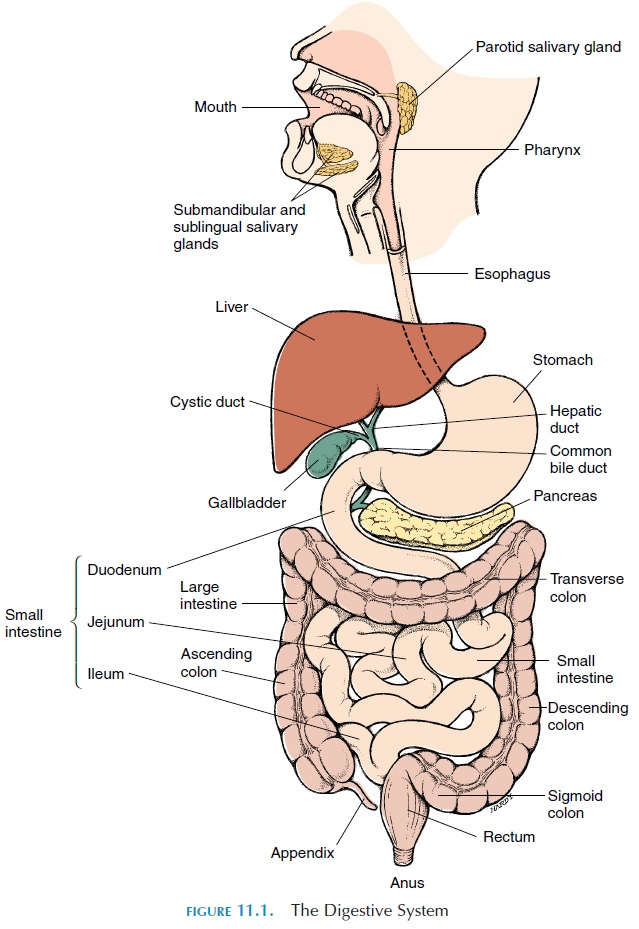Chapter: The Massage Connection ANATOMY AND PHYSIOLOGY : Digestive System
Large Intestine - Structure and Function of Digestive System
THE LARGE INTESTINE
The large intestine is much wider than the small in-testine. The large intestine (Figure 11.1) is about 6.5 cm (2.6 in) wide and 1.5 m (5 ft) long. The end of the ileum, guarded by the ileocecal valve (or sphincter), opens into the large intestine, which begins in the right lower quadrant of the abdomen. The large in-testine consists of three regions: the cecum, the colon, and the rectum. The rectum opens into theexterior via the anus. The main functions of the large intestine are to absorb water, sodium, and minerals from the chyme and make it more compact; absorb vitamins manufactured by the present bacteria; and, finally, to store fecal matter until it can be expelled from the body. The large intestine removes about 90% of the water in the chyme, reducing the 1–2 liters (1.1–2.1 qt) of chyme to 200–250 mL (about 0.2 qt) of feces passed per day.

The first part of the intestine—the cecum—has a small wormlike projection from the posteromedial side, the vermiform appendix. The appendix is about 7.5–15 cm (3–6 in) long, with a variable size and shape. It contains a large amount of lymphoid tissue. In hu-mans, it does not have an important function. Occa-sionally, the appendix becomes inflamed and produces the typical symptoms of appendicitis.
The colon can be subdivided into four parts—the ascending colon, the transverse colon, the de-scending colon, and the sigmoid colon—all namedaccording to their anatomy. The ascending colon as-cends from the right lower quadrant toward the liver in the posterior and lateral aspect of the abdominal cavity. Here, it makes a sharp bend, the hepatic flex-ure, to continue transversely as the transverse colonjust inferior to the stomach. To the left, it reaches the spleen before it bends inferiorly to continue as the descending colon. This bend is known as the splenicflexure. At the iliac fossa, the descending coloncurves inward and descends further as the sigmoid colon, the S-shaped segment of the large intestine. The sigmoid colon lies posterior to the urinary blad-der and becomes the rectum.
The rectum forms the last 15 cm (6 in) of the di-gestive tract. When food enters the rectum, there is an urge to defecate. The anus is the last few cen-timeters of the digestive tract. This region has circu-lar smooth muscles that form the internal analsphincter. Under voluntary control, the circularskeletal muscles located here form theexternal analsphincter.
The walls of the large intestine have cells that pro-duce large amounts of mucus. No enzymes are re-leased and no digestion occurs here. The longitudi-nally arranged smooth muscles in the walls of the colon form three bands called teniae coli. Because these longitudinal bands are shorter than the length of the colon, the wall of the colon forms outpouch-ings (haustra) between the teniae.
Feces
The feces contain inorganic material, undigested plant fibers, bacteria, and water. Surprisingly, a large fraction of the feces is of nondietary origin. Of the fe-ces, 75% is water and 25% is solids. Of the total solids, bacteria forms 30%; inorganic material, such as calcium and phosphate, 15%; fat and fat deriva-tives, 5%; and a variable amount of cellulose and in-digestible fiber, mucus, and mucosal cells that have sloughed off from the wall of the gut.
Bacteria and Colon
Although the jejunum contains little or no bacteria, the colon contains large numbers of bacteria. The bacteria in the colon are beneficial because many of them manufacture such vitamins as vitamin K and B complex. Chemicals formed by intestinal bacteria are largely responsible for the odor of the feces. Some bacteria residing in the intestine are harmful and may invade the body when the immunity is particu-larly low.
Dietary Fiber
Plant materials that reach the large intestine rela-tively unchanged are known as dietary fibers. Fibers are important to increase the bulk of the feces that is required to stretch the walls of the colon and initiate defecation. It has been shown that an intake of large amounts of vegetable fiber decreases the incidence of colon cancer, diabetes mellitus, and some types of heart diseases.
Related Topics